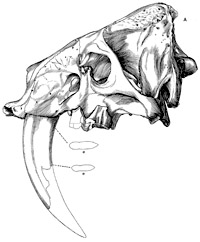Museum, University of Nebraska State

Bulletin of the University of Nebraska State Museum (1924–2023)
Date of this Version
4-1925
Document Type
Article
Citation
Bulletin of the Nebraska State Museum 1:4 (1925), pp 33.40
Abstract
A fragment of the lower jaw of a large fossil mammal with two well-worn teeth was dug up in June 1918, at a depth of 20 feet, while digging a cess pool at Bradshaw, York County, Nebraska. This unique specimen, accessioned 7-7-18, was brought to the Nebraska State Museum by A. Archie Dorsey, and was donated by C. B. Palmet, both of Bradshaw. It undoubtedly occurred in loess, which is thickly as well. as extensively developed in this region. It is a ruminant jaw, the teeth preserved being P4 and m1. The characteristic pattern of the premolar excludes reference to the Bovidae, and leaves the choice between the Giraffidae, Palaeomerycidae, and certain large Cervidae. The teeth are much larger than in any known cervid or palaeomerycid and agree better in proportions and pattern with the giraffes, especially certain fossil species from the Pliocene of China and India. If it is not a giraffe, it represents a wholly new genus of gigantic ruminant, rivalling the giraffe in size.
Included in
Entomology Commons, Geology Commons, Geomorphology Commons, Other Ecology and Evolutionary Biology Commons, Paleobiology Commons, Paleontology Commons, Sedimentology Commons


Comments
Copyright (c) 1925 THE NEBRASKA STATE MUSEUM